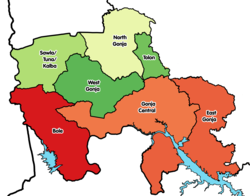Daboya | |
|---|---|
Location of Daboya in Savannah Region, Northern Ghana | |
| Coordinates: 9°31′49″N1°22′56″W / 9.53028°N 1.38222°W | |
| Country | Ghana |
| Region | Savannah Region |
| District | North Gonja District |
| Elevation | 338 ft (103 m) |
| Time zone | GMT |
| • Summer (DST) | GMT |
Daboya is the capital of the North Gonja district, a district in the Savannah Region of north Ghana. [1] It was previously called Burugu by the Dagomba people. [2] It was important in the trade route the stretched from Yendi to Bouna. This made Daboya one of the most important towns in Dagbon as at then. Today Daboya is represented by the Daboya-Mankarigu constituency. It is considered a historical place in Ghana. There is an Army Special Operations Training School at Daboya. [3]
Contents
Daboya is inhabited by the Gonja, Tampulma, Dagomba, and Hanga. [4]

















